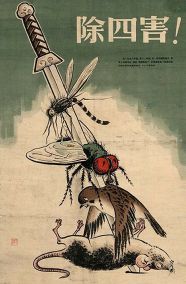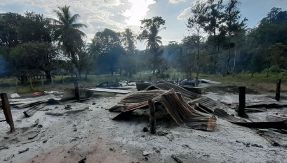Once upon a time ...
The stories will sound like individual cases, but of course they are not. We as human beings are balancing at the tipping point. We pretend to be the smartest beings on earth, meanwhile we are our biggest enemy.
Four Pest campaign
Mosquitoes, flies, rats and sparrows - these four so-called plagues were to be destroyed at the end of the 1950s under Mao Zedong's rule. Mao was certain that this was "the great leap forward" to combat economic and social social inequalities in the country. The calculation seemed logical. One sparrow eats about 2 to 4 kilos of grain a year and, on this assumption, by killing one million sparrows, 60,000 people could already gain food. One killing method was distrubing birds with incredible noise until they would fell to earth. The extermination was successful, but the death of the birds was followed by a raising population of insects and thus a plague of grasshopper. The result: the great famine between 1959 and 1961. In 1960 sparrows were placed in the agenda by bed bugs. It is said that a quarter of a million sparrows were later imported from the USSR to China. Today, sparrows are allowed to live in peace again nevertheless they become a rare species in China.
Racoons in Europe
At the beginning of the 20th century, the North American racoon was brought to Europe - for the fur industry. At some point, the animals were able to escape from their cages. Today they are considered a plague, as they have hardly any natural enemies in Central Europe. The situation is similar with raccoon dogs from Japan. Lynx, wolves, brown bears or, in the case of offspring eagle owls can also become enemies. The most common cause of death for raccoons is .... take a guess ... traffic.
Your biosphere is my backyard
In the early 90s, the conservative nicaraguan politician Violeta Barrios de Chamorro signed a decree to turn the second largest contiguous rainforest in Latin America into a nature reserve - Bosawás. This was shortly after the indigenous population was granted more autonomy and self-determination as a result of the Sandinista revolution. Some of them lived in this rainforest. At the same time, however, there were still numerous armed militant groups and ex-military. As there was no war to serve anymore they were settled with distance to the capital in a less populated region. A large group of armed farmers ended up next to Bosawás.
In 1997, Bosawas officially became a UNESCO biosphere reserve. Since then, there have been regular violent conflicts in the centre of Nicaragua. It is not uncommon for indigenous villages to be massacred. Houses are burnt down and people are murdered on their way to their fields. The indigenous autonomy enshrined in law is one of the most modern in the world. But it is not at all being implemented.
The establishment of a UNESCO biosphere reserve does not prioritise the protection of the local population. The indigenous people need the forest to survive, it is their food source, their medicine, their second lung. The new settlers, on the other hand, rely on conventional agriculture and due to this are causing immense environmental damage. Further international companies take advantage of the local disbalance as maragony wood and gold can be found in the forest. Meanwhile, the government has decided to prioritise waterfalls, monkeys and tourism over human rights. There was a paper published around 20 years ago called "Your biosphere is my backyard: the story of Bosawas in Nicaragua". Read it and you will understand! - "A decree is not a park" alas yalahna lằni


